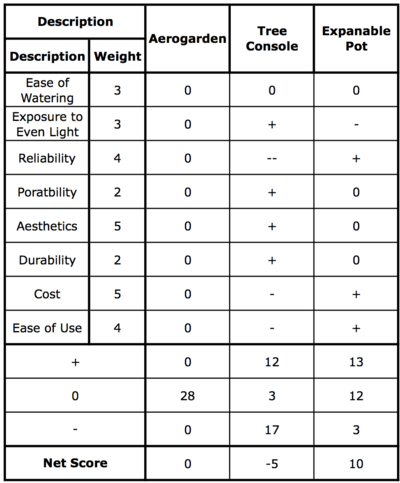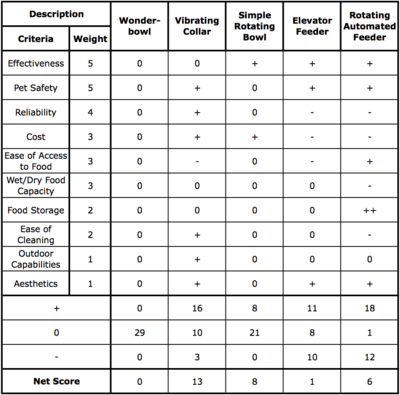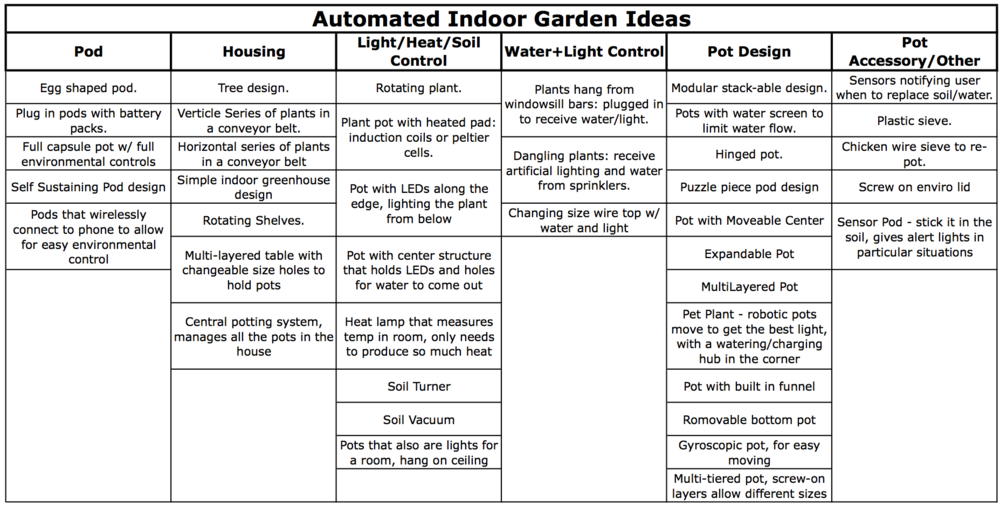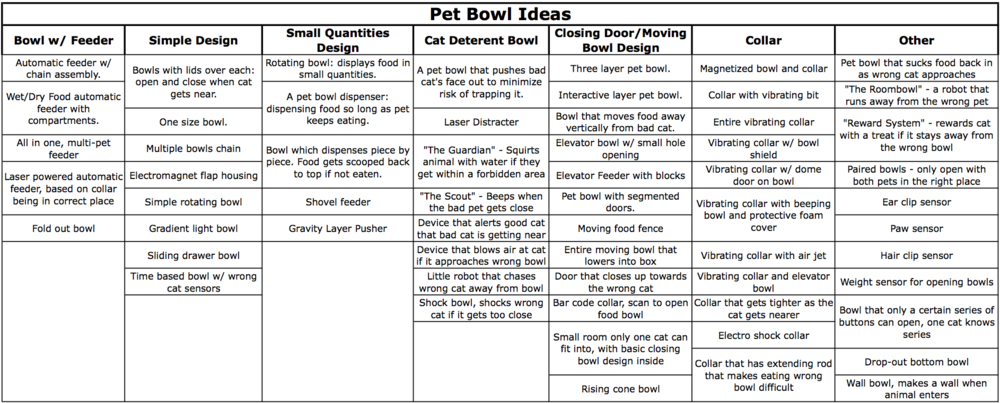Pet bowl and indoor garden opportunities
From DDL Wiki
Executive Summary
For this phase of the project we initially decided to explore two opportunities: indoor gardening and pet feeding. We did market research for both the indoor garden and the pet feeder and, after analyzing the findings, developed product ideas for each opportunity.
We discovered through market research for the indoor garden that there is large indoor gardening community and that people do it for multiple reasons. Some people grow their own herbs and spices, while others do it merely for aesthetics and as a way to relax. There is also a wide variety of effort levels people are willing to put in. Many just want to have an automated system while others want to water and take care of the plants. They car more about the process growing of the plants and really enjoy doing every part by hand. The current automated solution to indoor gardening in the AeroGarden which has 7 individual plant housings that can distribute nutrient rich water to the plants and has a light above for the plant.
The pet feeder market research showed us that there is a need for a better solution to feeding multiple pets. In households with multiple pets, it is common for one pet to eat the others food, which is not ideal in many situations such as when one pet in on a diet or needs to take individualized medicine. As it stands many of the current solutions are not good and keeping the pets from getting into each others bowls and actually can harm the pets. Also many of the current solutions are very expensive. One of the current products, the wonder bowl, uses a RFID activated lid to cover the food. However, this product has had complaints of closing on the pet and harming it.
Ultimately, we decided that creating a simple rotating bowl that has a compartment of food that has a rotating cover over it would be the optimal solution. We used a Pugh chart to weight the pros and cons of each design, and compared them against the wonder bowl. The vibrating collar had the highest score, but was too simplistic mechanically, which makes it a poor project to work on for the rest of the semester. The simple rotating bowl had the second highest score, so we decided it was the best project for this course. The simple rotating bowl uses a RFID sensor to identify the correct pet and a motor and encoder to control the rotation of the lid, the food can be kept away from incorrect pet and can keep the food fresh without fully trapping the pet like other competitor products.
Market Research
Observation Studies
Indoor Garden
To observe how people garden indoors, we visited Mary Lessard, an avid gardener who lives in the Allegheny Mountains. Mrs. Lessard owns a pair of Aerogardens, a small hydroponic device that allows her to grow fresh herbs in her kitchen any time of the year. In comparison to conventional gardening in potted soil, the Aerogarden is significantly easier to use. All Mrs. Lessard needs to do to keep her herbs healthy is refill the water and fertilizer reservoir on her Aerogarden, and the system will otherwise take care of itself.
However, she did have some problems with the Aerogarden system that left room for improvement. First, the system only accepts proprietary seed pods, limiting her selection of herbs to the ones that Aerogarden's manufacturers choose to sell. Also, the small system is unable to take care of larger plants, like most fruits or vegetables. Finally, because the Aerogarden uses a single reservoir to water and feed her plants, she needs to own two systems to care for different kinds of herbs and flowers.
Pet Bowl
As our observation study, we watched an individual take care of three pets during meal time, and even tried the feeding process ourselves. We fed one large cat, one small cat, and one small dog. We found that the large cat finished first and immediately went over to the small cat's bowl and started eating its food. We had to then manually move the big cat and then stand by the little cat's bowl while it ate. The big cat then would go over to the dog's bowl and start eating its food until we moved the large cat away again. We ended up sitting around for 15 min while the animals finished their food. The experience was rather annoying and time consuming, and the large cat was never really deterred from eating from the other animals' bowls. The pet owner faced the exact same challenges, and she hated the process, but didn't know of any other good solutions.
Other observations from the feeding process:
- The dog and the little cat did not put up a fight when the big cat came over to eat their food.
- The little cat did not eat all its food at once. It would walk away from the bowl for a few minutes, and then come back to finish.
- The dog and the little cat would sit next to their bowl while the big cat ate its food. They would wait patiently until the big cat left or was moved away and then would continue eating.
Expert Interviews
Indoor Garden
![Phipps Conservatory [1]](/ddl/images/thumb/Phipps.jpg/200px-Phipps.jpg)
For our expert interview for the indoor gardening idea, we interviewed a staff member of Phipps conservatory, Mr. Dunigan. Phipps is a plant conservatory located in Pittsburgh. Most of the plants are located indoors, in a very controlled environment, and are maintained by a full staff. Generally the plants are grown in a greenhouse located behind the conservatory and then moved out to the main area once fully grown. Mr. Dunigan and the other staff members grow all kinds of plants, from all over the world, and thus know a lot about the difficulties associated with indoor gardening.
Here are the main conclusions we drew from the interview with Mr. Dunigan:
- The hardest part of growing plants indoors is maintaining the environment. Plants often require specific environmental conditions and, if these conditions aren't met, the plants will die. On top of this, different plants can require very different conditions, which
- Heat and light is generally provided by a heat lamp, and the intensity of the heat lamp is dependent on the needs of the specific plant.
- Plants are watered carefully, as to not drown the plant. The amount of water used is also dependent on the needs of the specific plant.
- One common problem people have with growing plants at home is maintaining a temperature. Oftentimes, especially in places that have central heating and air conditioning, plants experience a wide range of temperatures, which can make plant growth difficult.
- Plants are very expensive to maintain.
Mr. Dunigan was very helpful in learning about indoor gardening and the difficulties involved, though it should be noted most of the issues he dealt with involved growing large numbers of plants in a greenhouse. This information is still very relevant to our topic and helpful when making our design choices in regards to indoor gardening.
Pet Bowl
We also interviewed a care taker named Brin who works at Mission Viejo Animal Shelter in California over the phone. This animal shelter takes care of a large number of animals but we inquired specifically about cats and dogs. We asked about the feeding process and how animals behave while eating. At the shelter, the pets are kept in kennels and to feed the pets, the volunteers or workers move a cart with clean bowls, a large bag of food and cans of wet food from kennel to kennel with a scooper and will dump dry or wet food into the appropriate bowls. The time it takes to finish eating varies from pet to pet according to Brin. She said that smaller pets tend to take their time eating while larger pets tend to eat much faster. After the pets are done eating, the bowls are collected and are then put in a washing machine.
Here are some of the observations she had of adopted pets and pets in the shelter.
- When eating the food would usually stay in the bowl while the animals eat
- Adopted animals usually do not eat in unfamiliar surroundings. They start eating once they feel comfortable in their new home.
- Adopted cats who enter a new household usually get along with other cats and don't have issues with eating each others food initially. However, adopted cats introduced into a new home with a pre-existing dog usually have issues with the dog eating the cats food and are instructed to keep the cats food away from the dog.
It should be noted that the pets in the shelter are kept spar so their eating habits were on an individual basis.
Surveys
Indoor Garden
To further explore peoples' attitudes about indoor gardening, we developed a brief survey on SurveyMonkey.com and posted it on reddit.com/r/indoorgardening, an online interest group for indoor gardeners. The survey asked demographic questions like age, gender and housing situation, as well as indoor gardening-specific questions like what sort of plants they grow and how much they'd be willing to spend on a system that automates gardening tasks. From the 30 people who responded to the survey, we were able to determine the following information:
Demographics:
- The average indoor gardener is 31 years old, but a majority of indoor gardeners are under 30 - The product should focus on young adults
- Nearly all of the survey respondents live in either a single-family house or an apartment
Gardening Behavior:
- The number of indoor plants people own varies widely, from 2 plants to over 50 - however, most respondents have between 10 and 20 indoor plants
- Over 60% of respondents would like to be able to regulate the temperature of their plants
- Over 75% of respondents prefer gardening in soil, rather than using hydroponic or aeroponic systems
- Most respondents are willing to pay roughly $100 for a system that automates gardening tasks
Pet Bowl
From surveying friends and online pet enthusiasts, we gained further insights into what pet owners would want from an automatic pet feeder. People were especially interested in a product that could combine feeding only certain pets certain foods with a timed product to feed pets if owners were out for a night or two. There was the biggest interest from people with multiple pets in their households, but it was also mentioned that this could be useful for research labs or kennels where multiple animals are kept. The biggest concern was pet safety, and it was pointed out to us that not everybody likes to keep collars on their pets while they are home. This is seen as a choking hazard by some pet owners. Other concerns raised were that the product would be inexpensive, $50-$100 was reasonable for people with a large need, and that the product was easy to clean.
Product Reviews
Indoor Garden
Through websites like Amazon, CNET, Mommy Poppins, and Pinterest we were able to learn about the main problems customers who want the ideal indoor garden face. A lot of people who have bought their own indoor gardens from competitors or have made theirs, wish their systems could work completely on their own. Customers want the system to be able to take care of all of the plant’s needs: water, light, nutrients, soil, temperature, and space.
A customer wants their experience cultivating plants to be simplified. Being able to replace plants is a challenge since plants must be re-potted and soil needs to be replaced. Some of the existing products do not handle this step and don’t notify the user when the plant must be re-potted.
Another feature customer look for, is a system that can be customized for each plant. If the water/light cycle could be set differently from each plant, that would be ideal. Customers would like pots to come in different sizes, be able to manage different types of water/light cycles, and also to be able to adjusts lights during the day and night. Current products don’t provide these settings to customers which are necessary if someone wants to produce more than one type of plant in their home.
Pet Bowl
The main concern pet owners have with automatic feeders (i.e. The Gatefeeder) is that the pet bowl could potentially harm their pets. Through online reviews, current pet bowl feeders with sensors have the tendency to close the lid/door on the pet. This can cause injuries, or can lead to the pet no longer wanting to eat from the bowl. Also, these sensors don't always work. When the sensor can't register the right pet it will open and close uncontrollably or simply not open at all. Similarly, many sensors were just too bulky, and pet owners didn't want such a large sensor hanging from their pet's collar. Lastly, an automatically closing pet feeder can be used to keep food fresh, stopping unwanted odor. In summary, from product reviews we learned pet owners want a product where they can store the food and have it accessible only by the correct pets without them having to fret about the pet's safety.
Summary of Stakeholder Needs
The main stakeholder for these products are the consumer. The consumer is the main person operating these devices and is the one who will suffer the most if they fail. Cost, reliability and safety are a few of the needs the consumer has from the products. However, the consumer isn’t the only group that these products has an impact on. Retailers, manufacturers, and Shippers/transporters also have interactions with the products.
Indoor Garden
| Primary | Secondary | |
|---|---|---|
| Consumers |
|
|
| Retailers |
|
|
| Manufacturers |
|
|
| Shipping/Transport |
|
|
Pet Bowl
| Primary | Secondary | |
|---|---|---|
| Consumers |
|
|
| Retailers |
|
|
| Manufacturers |
|
|
| Shipping/Transport |
|
|
Market Opportunities
Top 3-5 Design Concepts
|
Rotating Automatic FeederThis design is for people with multiple pets who don’t want the animals eating each other’s food and wants minimal upkeep. This bowl would most likely use an RFID sensor to identify when the correct pet is near and will rotate a pocket of food to an open position so the pet can consume the food. When the pet goes away or the wrong animal approaches, the food pocket will rotate around the track to the enclosure where the pocket will be refilled by a hopper that is connected to a guiding tube. By rotating the pocket to the hopper everytime, the pet will always have food to eat, and the wrong pet cannot get to the other pets food. The center of the bowl also could be used for water. The food is loaded by lifting the cover of the enclosure and pouring in food. Pro:
Con:
Patent:
Elevator FeederThis design is similar to an existing product the Gatekeeper in the sense that it restricts the number of pets that can reach the food at one time, but instead of using a housing to do this it uses elevation and a ramp. Initially this housing has the food in a lowered position with a barrier, but once the correct cat gets close to the housing, the food gets raised up and the barrier is moved. The pet walks up a ramp and can poke its head in the bowl and eat. If the wrong pet comes near the bowl or the correct cat leaves, the food will be lowered so the pet cannot eat the food and to prevent falling, the barrier is raised so as to push the pet upwards. The food is loaded by opening a compartment when the bowl is in the lowered position taking out the bowl and pouring more food in. Pro:
con:
Patents:
Simple Rotating BowlThis design uses a simple motor to rotate a cover that is over a partitioned bowl. When the correct pet approaches, the cover rotates to a compartment with food. If the correct pet moves away from the bowl or the wrong pet moves toward the bowl, the cover rotates to block the food. The motor would be activated by a RFID sensor and the food would be loaded by lifting the cover making the product easy to clean. Pro:
Con:
Patents: US6349671 B1 (Rotating multiple pet feeder): Uses sensor to open appropriate compartment.
Vibrating Color W/ BowlWhere the other designs focus on stopping the wrong pet from getting to the food, this design aims to keep the incorrect pet away from the bowl entirely. Like the other designs, this vibrating collar would have an RFID sensor attached to the pet via its collar that would start to vibrate using an offset weight to generate the vibration. Once the pet gets close to the wrong bowl, the vibrations would start making it difficult to eat. The amount of vibration would also be proportional to the distance the pet was in relation to the bowl. The closer the pet is to the wrong bowl, the stronger the vibration. Pro:
Con:
Pantents:
Tree ConsoleInstead of having a singular housing for all of ones plant, this design allows the user the option to move his or her plants around his or her apartment or house. The pods have to be plugged into the walls or the center console that is shaped like a tree. The pods have water tanks that allow the user to fill them up and the sensors will regulate the amount of water the plants will get. The pods also have LED lights that give the plant even light. The pods and the center console are designed to look aesthetically pleasing, but due to the large number of sensors, the pods are slightly difficult to program. Pro:
Con:
Patents: US 8549788 B2 (Hydroponic growing system): Uses a planting trough, solar panels, and liquid nutrients to care for plants. Competitor ProductsWeb Searches
Pugh ChartsIndoor Gardening
|
|||||||||||||||||||||||||||||||||||||||||||||||||||||
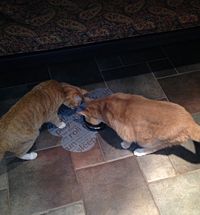
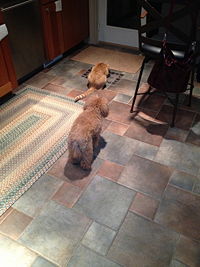
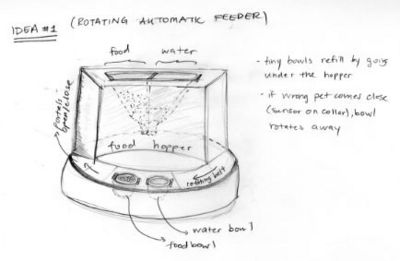
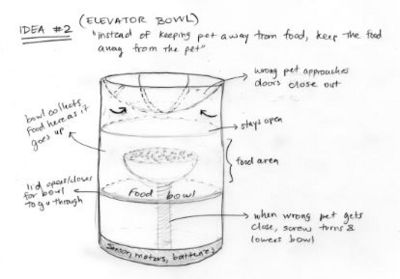
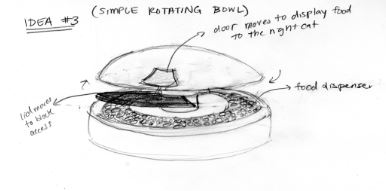
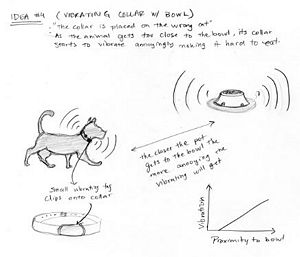
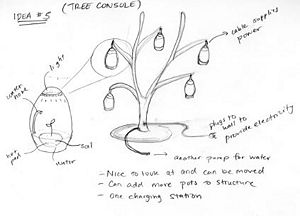
![[2]](/ddl/images/thumb/Clickandgrow.jpg/200px-Clickandgrow.jpg)
![[3]](/ddl/images/thumb/AeroGarden.jpg/200px-AeroGarden.jpg)
![[4]](/ddl/images/thumb/Windowfarms.jpg/200px-Windowfarms.jpg)
![[5]](/ddl/images/thumb/Gatefeeder.png/200px-Gatefeeder.png)
![[6]](/ddl/images/thumb/Petwonderbowl.png/200px-Petwonderbowl.png)
![[7]](/ddl/images/thumb/Automaticpetfeeder.jpg/200px-Automaticpetfeeder.jpg)
![[8]](/ddl/images/thumb/Vibratingcollar.jpg/200px-Vibratingcollar.jpg)
